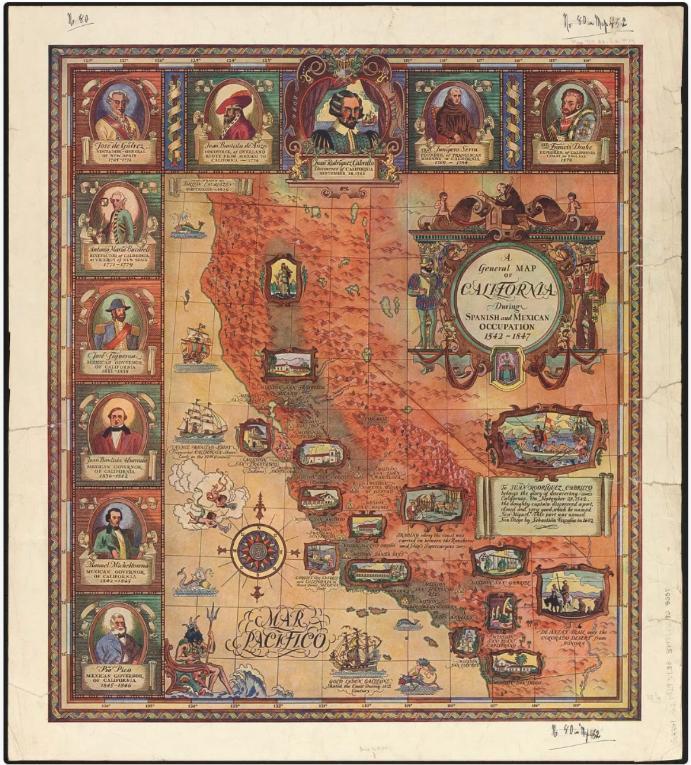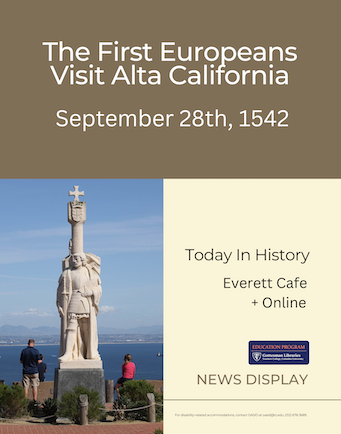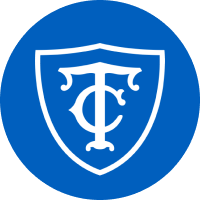Today In History: The First Europeans Arrive in Alta California

A soldier and explorer for the Spanish Crown, Juan Rodríguez Cabrillo was known as the "discoverer" of California; on September 28th, 1542, he and his crew aboard the San Salvador and the Victoria landed at San Diego Bay and claimed it for Spain, despite the indigenous people living there. Cabrillo was believed to be the first European to explore the West Coast of the United States, including California's channel islands, from Baja California to northern California. While little is known of Cabrillo's early life, his arrival in Alta California signaled the beginning of occupation, first by Spain and then by Mexico, through 1847. During this time as many as 21 missions were created along the coast in an effort to spread Catholicism, while small towns, known as pueblos, would become San Diego and Los Angeles -- home to more Europeans, the English among them.
Native Americans, including the Chowigna and Suangna, lived in the Palos Verdes peninsula (southwestern Los Angeles County) for at least 7,000 years. Archaeological treasures, such as arrowheads, stone tools, and skeletal remains in burial sites, confirmed their existence and drew attention to the significant role of indigenous peoples in the history and cultures of the Americas. From the 16th through the 19th centuries populations of Native Americans declined due to a variety of factors, including epidemic diseases from Europe; violence and warfare with European explorers and colonists; and conflict between tribes, as well as their displacement or loss of land.
The following articles are drawn from Proquest Historical Newspapers, which informs and inspires classroom teaching and learning:
- A Pacific Fiesta.: Celebrating the Discovery of the California Coast. Cabrillo's' Famous Voyage, as Described by His Pilot. Interesting Description of Indians and Their Ways. (1892, Sep 25). Los Angeles Times (1886-1922)
- Juan Rodriguez Cabrillo. (1917, Feb 26). The Christian Science Monitor (1908-)
- Development of Port Helped to Bring Success to San Diego: Juan Rodriguez Cabrillo, in 1642, Described the Bay He Discovered. (1923, Dec 21). The Christian Science Monitor (1908-)
- George, W. K. (1927, Sep 18). September in California History. Los Angeles Times (1923-1995)
- Barry, R. A. (1935, May 05). Stamp Notes: California Exposition. New York Herald Tribune (1926-1962)
- San Diego to Re-enact in 1942 California's Discovery in 1542. (1937, Nov 10). The Christian Science Monitor (1908-)
- Hunt, R. D. (1938, Nov 27). California's Stately Hall of Fame: II--Juan Rodriguez Cabrillo. Los Angeles Times (1923-1995)
- Historian Will Hunt for Traces of Juan Cabrillo: Will Search Central America for Records to Help Cast Light on California Discoverer. (1965, Jan 11). Los Angeles Times (1923-1995)
- Stone Linked to Grave of 'Discoverer' on Coast. (1972, Dec 24) New York Times (1923-)
- Lucas, M. (1984, Aug 24). The Arrowheads and Skeletons Buried Beneath Peninsula Soil Prove: We Were Not Here First: Indians: Paying Tribute. Los Angeles Times (1923-1995)
- Murphy, W. S. (1986, Oct 11). Reliving the Day Cabrillo Landed at San Pedro: Thousands Are Expected to See the Reenactment. Los Angeles Times (1923-1995)

Tips:
- Britannica, Educational Publishing Staff. The Age of Exploration : From Christopher Columbus to Ferdinand Magellan, edited by Kenneth Pletcher, Rosen Publishing Group, 2013. e-book
- Laverty, Corinne Heyning. North America’s Galapagos : the Historic Channel Islands Survey Biological Survey. Salt Lake City: University of Utah Press, 2020. e-book
- The American Curriculum Collection. See holdings relating to California. Teachers College Digital Collections.
Images:
- Lauritzen, Dillon. A General Map of California During Spanish and Mexican Occupation, 1542-1847. Published in 1929. Norman B. Leventhal Map & Education Center. Courtesy of Boston Public Library
- Poster Image: Statue of Juan Rodríguez Cabrillo at Cabrillo National Monument, Point Loma, San Diego, California. Photo by Bernard Gagnon. Courtesy of Wikimedia Commons.
Need to keep current, look to the past, teach a topic? The Everett Cafe features daily postings of news from around the world, and also promotes awareness of historical events from an educational context. Be sure to check additional Cafe News postings on the library blog.



